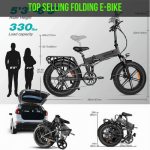
Electric bikes, or e-bikes, are a revolutionary invention that has changed the way we move around. A perfect example of this is my friend, who recently purchased an e-bike to get around his university campus. He was able to travel much further and faster than before, and was amazed by how little effort it took. With this newfound freedom, however, comes questions about how much electricity these bikes actually use.
As an e-bike expert, I’m here to answer this question and more so let’s dive in!
E-bikes have become increasingly popular over the last few years: they’re convenient, and fast and often come with multiple features that make them even more attractive to potential buyers. In addition to making your travels easier and faster, though, do e-bikes actually use a lot of electricity? To answer this question, we’ll need to look at several factors including battery type and usage patterns.
The amount of electricity used by an e-bike depends on the type of battery it uses and how often the bike is ridden. For instance, if you’re using a lithium-ion battery and riding your bike every day for long distances, your bike may consume more electricity than someone who rarely uses their electric bike. Additionally, different types of batteries can affect the amount of electricity consumed as well; for example, lead-acid batteries tend to take longer to charge but are also typically cheaper than other types of batteries.
So do e-bikes really use a lot of electricity? The answer depends on several factors such as battery type and usage patterns but overall electric bikes don’t require too much extra energy compared to traditional bicycles. In the next paragraphs, we’ll explore these topics in greater detail so you can make an informed decision about whether or not an electric bike is right for you.
Contents
Do Ebikes Use a Lot of Electricity?
1. Benefits of Electric Bike Usage
Ah, the joy of feeling the wind in your hair and being one with nature as you coast down a country road on an electric bike. It’s like freedom embodied the experience of the open road without any motorized noise or fumes. And to think that this freedom is powered by electricity!
Indeed, electric bikes have become increasingly popular for their convenience and environmental benefits.
There are many advantages to using electric bicycles beyond just being able to get around faster than walking or cycling. For starters, they require very little electricity to run, typically costing much less than a penny per mile compared to cars that can cost up to $1 per mile. Additionally, electric bikes generate zero emissions, helping reduce global warming and its repercussions.
Furthermore, they’re easy to maintain since there are no fluids or motors involved just charge it up at night and you’re good to go! Not only do these bikes offer a great deal of convenience but they also provide an excellent form of exercise you can choose how fast or slow you want to go while still getting your daily dose of movement. And let’s not forget about the financial benefits: e-bikes usually cost much less than cars and scooters yet provide similar levels of mobility.
Electric bikes offer a plethora of benefits including reduced emissions, low energy costs, ease of use and maintenance, and cost savings over traditional vehicles all while providing users with a sense of freedom and adventure!
2. Electric Bike Electricity Consumption
When it comes to using electric bikes, one of the most common questions asked is: Do they use a lot of electricity? Well, I’m here to tell you that the answer is no. Electric bikes use very little electricity compared to other modes of transportation.
Electric bikes are powered by a battery and on average, take about 4-6 hours for a full charge. The amount of electricity an electric bike consumes depends on how often you ride it and how far you go. For example, if you’re only riding around your neighborhood, it’s likely that your bike won’t consume a lot of electricity since it doesn’t require as much power to get around a shorter distance.
On the other hand, if you’re taking long trips across town or even cross country, then the bike will need more power and thus more electricity consumption. But generally speaking, electric bikes are still very efficient when it comes to energy consumption. They allow riders to enjoy their freedom without having to worry about wasting electricity or spending too much on gas.
Conclusion
Using an electric bike has many advantages, both personal and environmental. It’s a great way to get around while being kind to the environment. But one of the most common questions I get asked is, do E-bikes use a lot of electricity?
The answer is no. On average, an e-bike uses about 250 watt-hours per charge. That’s about the same amount of energy as a light bulb uses in two hours! To put it into perspective, if you rode your bike for two hours every day for a month, it would cost you less than $2 in electricity costs.
It’s clear that electric bikes are not only good for the environment, but they also don’t require large amounts of electricity to operate. As an e-bike enthusiast myself, I can attest to the fact that riding an electric bike is a great way to be both kind to the planet and cost-effective. You can enjoy the ride without worrying about breaking your budget with electricity costs!



